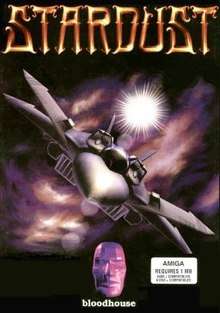Stardust (1993 video game)
Stardust is a multidirectional shooter video game for the Amiga, released by the Finnish company Bloodhouse in 1993. The game is essentially an Asteroids clone with enhancements, such as power-ups, shields, a high-energy techno module soundtrack, vivid use of colors and the occasional tunnel section that revolves around a sphere. The game's graphics drew critical acclaim for the aforementioned tunnels and the liberal use of ray-tracing. The company has since merged with Terramarque to form Housemarque.
| Stardust | |
|---|---|
 | |
| Developer(s) | Bloodhouse |
| Publisher(s) | Bloodhouse |
| Platform(s) | Amiga, Atari ST, MS-DOS |
| Release |
|
| Genre(s) | Multidirectional shooter |
| Mode(s) | Single-player |
In a not atypical bout of Finnish humor, the developers gave several things ludicrous names in their own language, which were (and still are) highly obscure in the international market. The damsel in distress is named after a brand of margarine, and the final confrontation takes place over the planet Imatra.
Ports
The game was ported to MS-DOS, but not by the original programmers. This version was buggy, scant on details found in the Amiga version and severely lacking in both control and gameplay polish.
Conversion made for the Atari STE by Aggression demoscene crew was published in 1995 by Daze Marketing. It is one of the few games to use the Atari STE's updated capabilities.
Legacy
An enhanced sequel was released for AGA Amigas, Amiga CD32, and finally for the IBM PC compatible platform as well. Named Super Stardust (or Super Stardust '96), the game features a CD soundtrack from Slusnik Luna, FMV cut-scenes, high speed gameplay and completely new levels and enemies.
In April 2007, Sony Computer Entertainment released Super Stardust HD as a downloadable PlayStation Network game for the PlayStation 3.[1]
In February 2012, Super Stardust Delta was released on the PlayStation Network as a downloadable title for the PlayStation Vita.
References
- Puha, Thomas (2007-04-06). "Previews: Super Stardust HD". 1up.
External links
- Stardust at the Housemarque website
- Stardust at Atari Mania
- The MS-DOS version of Stardust can be played for free in the browser at the Internet Archive